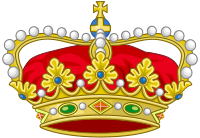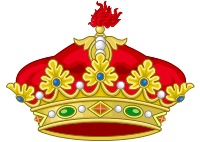Spanish nobility
| Royal Titles |
|---|
 The crown of the Spanish monarch |
 The crown of the Princess of Asturias (crown princess) |
 The coronet of an infante (prince) |
| Titles of nobility |
 A coronet of a grandee |
 A Spanish coronet of a duke |
 A Spanish coronet of a marquess |
 A Spanish coronet of a count |
 A Spanish coronet of a viscount |
 A Spanish coronet of a baron |
|
A Spanish coronet of a señor (lord) |
Spanish nobles are persons who possess the legal status of hereditary nobility according to the laws and traditions of the Spanish monarchy. A system of titles and honours of Spain and of the former kingdoms that constitute it comprise the Spanish nobility. Some nobles possess various titles that may be inherited, but the creation and recognition of titles is legally a prerogative of the King of Spain.
Some noble titles and families still exist which have transmitted that status since time immemorial. Some aristocratic families use the nobiliary particle de before their family name. During the rule of General Francisco Franco, some new hereditary titles were conceded to individuals, and the titles granted by the Carlist pretenders were officially recognized.
Despite accession to Spain's throne of Juan Carlos I in 1975, the court of nobles holding positions and offices attached to the royal household was not restored. Noble titleholders are subjected to taxation, whereas under Spain's ancien régime (until 1923) they were exempt. King Juan Carlos resumed conferral of titles to recognize those whose public service, artistic endeavour, personal achievement, philanthropy, etc. are deemed to have benefitted the Spanish nation.
Spanish nobles are classified as either grandees, as titled nobles, or as untitled nobles.
In the past, grandees were divided into first, second, and third classes, but this division has ceased to be relevant in practice while remaining a titular distinction; legally all grandees enjoy the same privileges in modern times. At one time however, each class held special privileges such as:
Additionally, all grandees were addressed by the king as mi Primo (my Cousin), whereas ordinary nobles were only qualified as mi Pariente (my Kinsman).
An individual may hold a grandeeship, whether in possession of a title of nobility or not. Normally, however, each grandeeship is attached to a title. A grandeeship is always attached to the grant of a ducal title. The grant of a grandeeship with any other rank of nobility has always been at the will of the sovereign. Excepting dukes and some very ancient titles of marquises and counts, most Spanish titles of nobility are not attached to grandeeships.
...
Wikipedia
